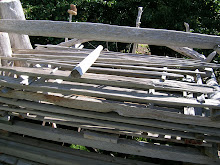
Duality Exercise#2: Polarity
Take a familiar polarity, black and white, good and bad, etc. Line it up on a continuum from most so to most the opposite. Now consider some aspect of reality that intersects the continuum and that slices it along that new direction.
For example, let’s take some found object and play with it with the intent to transform it by marrying it with an opposite. We might take an unused packaged object and remove it from its package. Find an almost used up similar object and repackage it. Repackage it attentively so that the caged worn element offsets the new packaging. Wrapping could serve as the alternate axis that unites and resolves the new and old object duality.
What could we do with black and white? Collect objects of varying shades of grey and place them in a container that has only black and white marks on it. Write with a black marker one aspect, let’s say the collection time of each object and write with a white out marker the location of the find. Consider the value of the object by adding one colored object. In color theory value derives from pigment, while shade grades from black to white. The colored element shifts the axis. The time and space continua hold white and black in some balance.
How about reworking good and bad?
On a relativistic level we may have noticed that from someone’s perspective the bad event serves a purpose that someone considers not bad and for others the good event serves a purpose that they consider not good. In fact for a larger and larger group of people the events have varying degrees of goodness. We need to spend a lot more time exploring these degrees of goodness, if we want to effectively instigate and support peace.
 An educator likes to remind parents that when children fight over an object the best refocusing solution involves grabbing the object and running with it. This offers the children the opportunity to turn their united focus on retrieving the object. Now surrendering the object redraws the lines of alliance. Although no proponent of war or disaster, most survivors of disasters and major conflict report stories of deep connection as the community refocuses priorities on survival. The rules shift and they transform the duality.
An educator likes to remind parents that when children fight over an object the best refocusing solution involves grabbing the object and running with it. This offers the children the opportunity to turn their united focus on retrieving the object. Now surrendering the object redraws the lines of alliance. Although no proponent of war or disaster, most survivors of disasters and major conflict report stories of deep connection as the community refocuses priorities on survival. The rules shift and they transform the duality.

No comments:
Post a Comment